
Robert Adam was a British neoclassical architect, interior designer and furniture designer. He was the son of William Adam (1689–1748), Scotland's foremost architect of the time, and trained under him. With his older brother John, Robert took on the family business, which included lucrative work for the Board of Ordnance, after William's death.
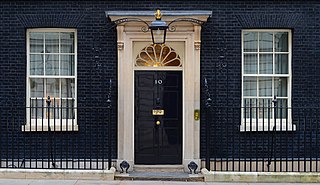
10 Downing Street in London is the official residence and office of the prime minister of the United Kingdom. Colloquially known as Number 10, the building is in Downing Street, off Whitehall in the City of Westminster. 10 Downing Street is the current residence of the current prime minister Keir Starmer, since 2024 after succeeding former prime minister Rishi Sunak.

The Scottish Government is the executive arm of the devolved government of Scotland. It was formed in 1999 as the Scottish Executive following the 1997 referendum on Scottish devolution, and is headquartered at St Andrew's House in the capital city, Edinburgh. It has been described as one of the most powerful devolved governments globally, with full legislative control over the economy, education, healthcare, justice and the legal system, rural affairs, housing, the crown estate, the environment, the fire service, equal opportunities, the transportation network, and tax, amongst others.

The first minister of Scotland, formally known as the First Minister and Keeper of the Scottish Seal, is the head of government of Scotland. The first minister leads the Scottish Government, the executive branch of the devolved government and is the keeper of the Great Seal, one of the great officers of state in Scotland.

Lansdowne House now 9 Fitzmaurice Place is the remaining part of an aristocratic English town house building to the south of Berkeley Square in central London, England. The initial name was for two decades Shelburne House, then its title matched its owning family's elevation to a higher peerage in 1784. In the mid to late 19th century, it was frequently let, as a whole, to families of very high wealth or income, such as Lord Rosebery and Hannah de Rothschild of Mentmore Towers from 1878 to 1890. Some of its 18th-century interiors, among the best in London, were taken elsewhere. It was at different times leased by three 19th century British prime ministers, and William Waldorf Astor, 1st Viscount Astor of Cliveden House, widely believed to be the richest man in America at the time of his tenancy (1891–1893) and also by Harry Gordon Selfridge in the 1920s. Landsdowne's heirs sold the property in 1929, two years after the death of the 5th Marquess, a prominent government frontbencher.
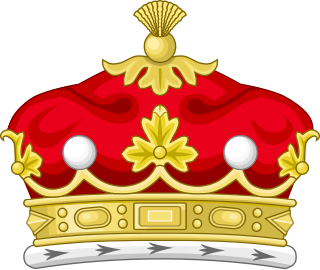
Marquess of the County of Bute, shortened in general usage to Marquess of Bute, is a title in the Peerage of Great Britain. It was created in 1796 for John Stuart, 4th Earl of Bute.

National Galleries Scotland: Portrait is an art museum on Queen Street, Edinburgh. Portrait holds the national collections of portraits, all of which are of, but not necessarily by, Scots. It also holds the Scottish National Photography Collection.
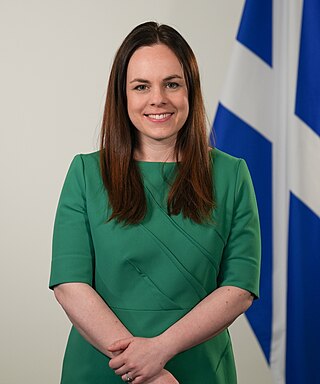
The deputy first minister of Scotland is the second highest minister in the executive branch of the Scottish Government, after the first minister of Scotland. The post-holder deputises for the first minister during periods of absence or whilst out–with the country conducting overseas visits. During any period of the first minister's absence, the deputy first minister will be expected to answer to the Scottish Parliament on behalf of the First Minister at First Minister's Questions. Additionally, the holder of the office of deputy first minister serves within the Scottish cabinet as a cabinet secretary, a position they hold in conjunction with their responsibilities as deputy first minister.

John Crichton-Stuart, 4th Marquess of Bute, KT, was a Scottish peer.
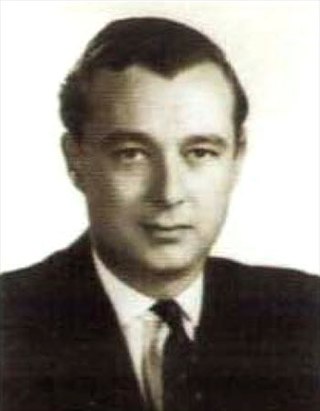
John Crichton-Stuart, 6th Marquess of Bute, was a Scottish peer, benefactor and patron of the arts. He was largely known either as Lord Bute or simply John Bute.

Charlotte Square is a garden square in Edinburgh, Scotland, part of the New Town, designated a UNESCO World Heritage Site. The square is located at the west end of George Street and was intended to mirror St. Andrew Square in the east. The gardens, one of the collection of New Town Gardens, are private and not publicly accessible.
The National Archives of Scotland (NAS) is the previous name of the National Records of Scotland (NRS), and are the national archives of Scotland, based in Edinburgh. The NAS claims to have one of the most varied collection of archives in Europe. It is the main archive for sources of the history of Scotland as an independent state, her role in the British Isles and the links between Scotland and many other countries over the centuries.
Colin McWilliam (1928–1989) was a British architecture academic and author.

The Scottish Cabinet is the main decision-making body of the Scottish Government, the devolved government of Scotland. It is headed by the first minister, and made up of cabinet secretaries of the Scottish Government, the Lord Advocate and Solicitor General for Scotland, the Permanent Secretary to the Scottish Government and the Minister for Parliamentary Business.

Dumfries House is a Palladian country house in Ayrshire, Scotland. It is located within a large estate, around two miles (3 km) west of Cumnock. Noted for being one of the few such houses with much of its original 18th-century furniture still present, including specially commissioned Thomas Chippendale pieces, the house and estate is now owned by The King's Foundation, a charity which maintains it as a visitor attraction and hospitality and wedding venue. Both the house and the gardens are listed as significant aspects of Scottish heritage.

The Palace of Holyroodhouse, commonly known as Holyrood Palace, is the official residence of the British monarch in Scotland. Located at the bottom of the Royal Mile in Edinburgh, at the opposite end to Edinburgh Castle, Holyrood has served as the principal royal residence in Scotland since the 16th century, and is a setting for state occasions and official entertaining.
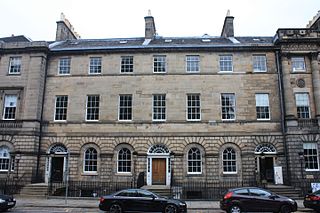
The Georgian House is an 18th-century townhouse situated at No. 7 Charlotte Square in the heart of the historic New Town of the city of Edinburgh, Scotland. It has been restored and furnished by the National Trust for Scotland, and is operated as a popular tourist attraction, with over 40,000 visitors annually.

Governor's House is a building situated on the southernmost spur of Calton Hill, beside the south-east corner of Old Calton Burial Ground, in Edinburgh, Scotland. It looks out over Waverley Station, the Canongate and Holyrood Park to the south.

Acheson House is a 17th-century house in the Old Town of Edinburgh, Scotland. It was built in 1633 for Sir Archibald Acheson, 1st Baronet, Secretary of State of Scotland for King Charles I. It did not stay in the Acheson family, and during the 19th century it declined like much of the Old Town. Slum clearance led the city council to acquire the building in 1924, but the Marquess of Bute bought it to have it restored during the 1930s. It was later used by church and arts groups, but was vacant between 1991 and 2011. In November 2011, Acheson House became the base for the Edinburgh World Heritage Trust. The ground floor of the building will become part of the Museum of Edinburgh, based in the adjacent Huntly House.
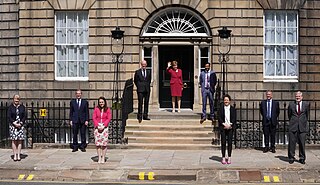
Nicola Sturgeon formed the third Sturgeon government following her Scottish National Party's victory in the 2021 Scottish Parliament election. Sturgeon was nominated by a vote of the 6th Scottish Parliament for appointment to the post of First Minister on 18 May 2021 and announced the formation of a new Scottish National Party minority government on 19 May.
































